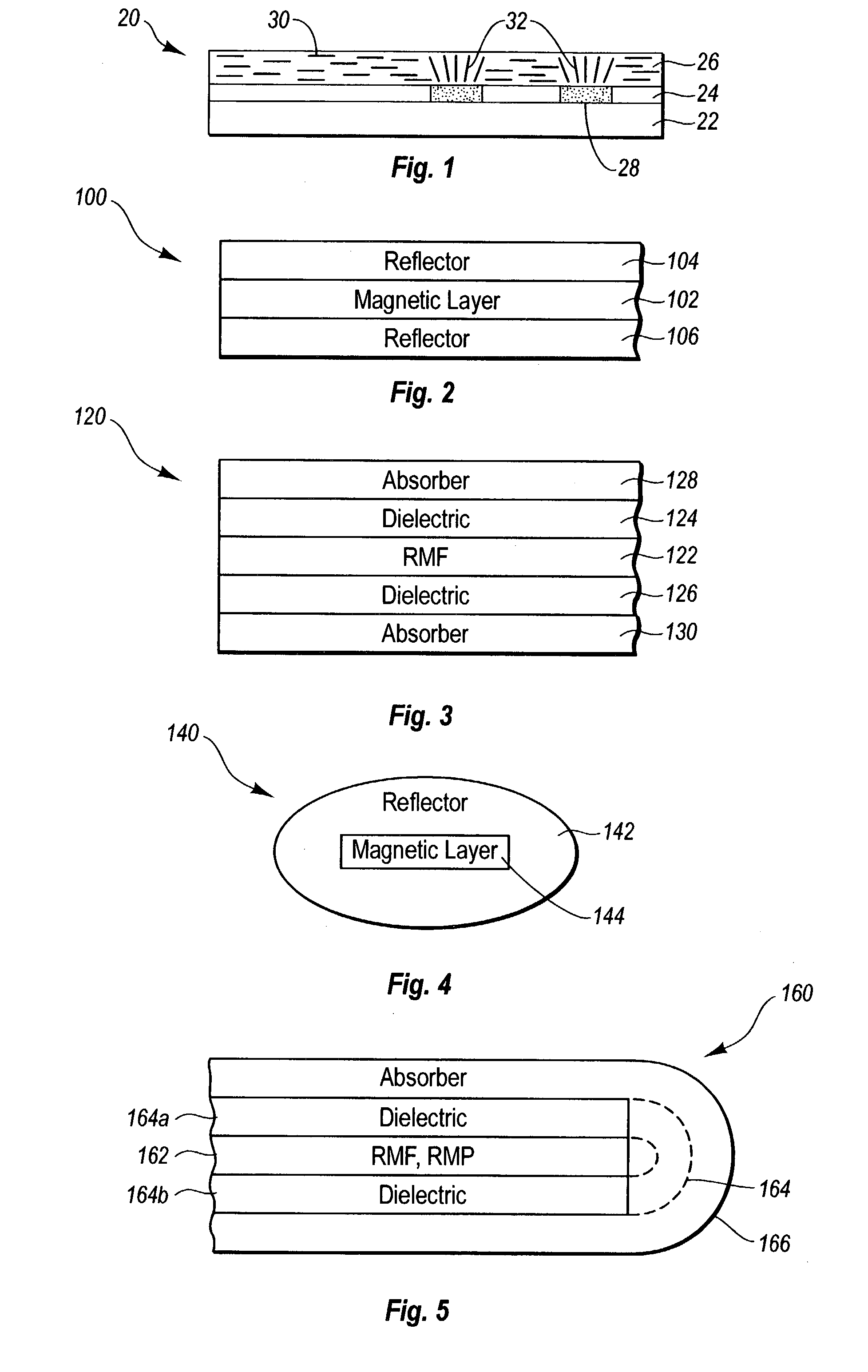Methods for producing imaged coated articles by using magnetic pigments
a technology of magnetic pigments and coated articles, applied in the direction of dyeing process, electric/magnetic/electromagnetic heating, magnetic bodies, etc., can solve the problems of not discussing the use of optical thin film stacks or platelets employing magnetic layers, using poorly reflecting metals, and not teaching the use of thin film optical stacks. achieve the effect of maximizing the ability to align flakes, narrow line widths, and enhanced optical effects
- Summary
- Abstract
- Description
- Claims
- Application Information
AI Technical Summary
Benefits of technology
Problems solved by technology
Method used
Image
Examples
example 2
[0134] A magnetic ink sample was prepared by mixing a 0.5 g sample of the magnetic pigment of Example 1 (Al / Fe / Al) with 3.575 g of standard Intaglio ink vehicle (high viscosity ink vehicle) and 0.175 g of an ink dryer. The ink sample was drawn down onto paper using a flat putty knife. A magnetic strip with the word "FLEX" cut out from it was placed beneath the paper during the drawing down step. The pattern of the magnetic lines in the dried magnetic ink was readily visible as black and white (silver color) strips with the word "FLEX" readily apparent. The optical image of the word "FLEX" in the ink sample was visible at normal incidence and at approximately a 45 degree angle of viewing.
example 3
[0135] A magnetic ink sample was prepared as in Example 2 using an Intaglio ink vehicle and coated over paper having a sheet magnet placed behind it. The magnet had a cut out of a stylized letter "F." In addition to the magnetic pigment (Al / Fe / Al) orienting along the magnetic field lines, the cut out "F" was embossed upward away from the paper and was bright silver in appearance. The "F" stood out over the surrounding area by about 6 microns. This was caused by the paper pushed slightly into the "F" recess of the magnet by the force of the putty knife drawing down the highly viscous Intaglio ink. After the paper relaxed, the "F" area remained bright with the Al / Fe / Al flakes oriented parallel to the surface of the paper but in a stepped-up height above the surrounding coating.
example 4
[0136] A stylized letter "F" was cut out of a flexible sheet magnet using an exacto knife. A draw-down card was placed on top of and in contact with the sheet magnet. A magnetic color shifting pigment according to the invention was mixed with an acrylic resin based vehicle and applied to the card with a #22 wire mayer rod. The resultant draw-down had striped superimposed black lines that replicated the field pattern outside of the stylized "F" in the sheet magnet below the card. The entire surface of the drawn-down card exhibited color shifting effects. Where the pattern of the stylized "F" was observed, the stylized "F" only had color shifting effects, while the background had both color shifting effects and the superimposed black lines.
[0137] The cut out stylized letter "F" pieces from the sheet magnet were used in another draw-down with the same magnetic pigment and vehicle described previously in this example. The resultant draw-down had striped superimposed black lines that rep...
PUM
| Property | Measurement | Unit |
|---|---|---|
| particle size distribution | aaaaa | aaaaa |
| Coercivity | aaaaa | aaaaa |
| coercivities | aaaaa | aaaaa |
Abstract
Description
Claims
Application Information
 Login to View More
Login to View More - R&D
- Intellectual Property
- Life Sciences
- Materials
- Tech Scout
- Unparalleled Data Quality
- Higher Quality Content
- 60% Fewer Hallucinations
Browse by: Latest US Patents, China's latest patents, Technical Efficacy Thesaurus, Application Domain, Technology Topic, Popular Technical Reports.
© 2025 PatSnap. All rights reserved.Legal|Privacy policy|Modern Slavery Act Transparency Statement|Sitemap|About US| Contact US: help@patsnap.com



